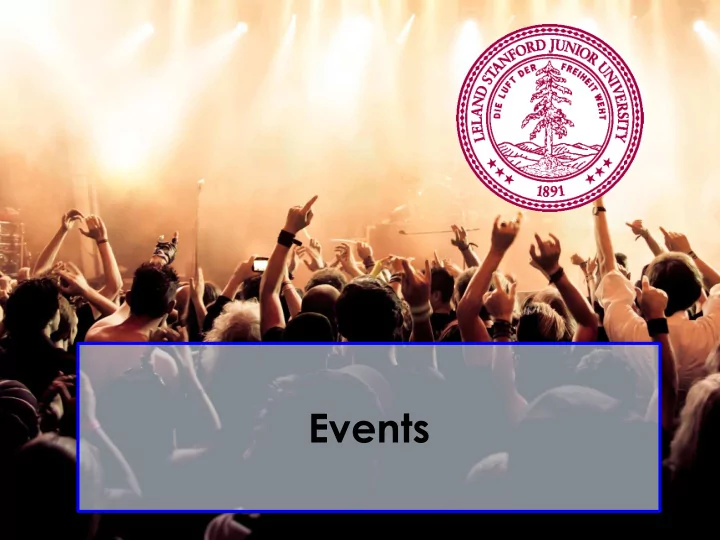

Events
Where are we?
Stamp Tool
Catch Me If You Can
We’ve Gotten Ahead of Ourselves Source: The Hobbit
Start at the Beginning Source: The Hobbit
Learning Goals 1. Write a program that can respond to mouse events 2. Use an instance variable in your program
Listener Model • When users interact with computer they generate events (e.g., moving/clicking the mouse) • Can respond to events by having listener for events addMouseListeners() • Listeners get control of the program when an event happens. Using portions of slides by Eric Roberts
Responding to Mouse Events 1. The run method should call addMouseListeners 2. Write definitions of any listener methods needed mouseClicked( e ) Called when the user clicks the mouse mousePressed( e ) Called when the mouse button is pressed mouseReleased( e ) Called when the mouse button is released mouseMoved( e ) Called when the user moves the mouse Called when the mouse is dragged with mouseDragged( e ) the button down The parameter e is MouseEvent object, which provides more data about event, such as the location of mouse. Using portions of slides by Eric Roberts
Hole Puncher
Now With Dancing Children
Normal Program Run Method
New Listener Characters Mouse Listener Mouse Clicked Method
Program Starts Running Run Method Mouse Clicked Method
Add Mouse Listener Mouse Listener Run Method Mouse Clicked Method addMouseListeners();
Program Runs as Usual Mouse Listener Run Method Mouse Clicked Method
Mouse Clicked! Mouse Listener Run Method Mouse Clicked Method
Calls Mouse Clicked Method Mouse Listener Run Method Mouse Clicked Method
When done, Run continues. Mouse Listener Run Method Mouse Clicked Method
Keeps Doing Its Thing… Mouse Listener Run Method Mouse Clicked Method
Mouse Moved! Mouse Listener Run Method Mouse Clicked Method
Calls Mouse Clicked Method Mouse Listener Run Method Mouse Clicked Method
When done, Run continues. Mouse Listener Run Method Mouse Clicked Method
Mouse Tracker
Instance Variables 1. Variables exist until their inner-most code block ends. 2. If a variable is defined outside all methods, its inner-most code block is the entire program! 3. We call these variables instance variables * Instance variables have special meanings in programs with multiple files. For now you need to know that all methods can see them and that their initialization line is executed before run.
Instance Variables + Events Often you need instance variables to pass information between the run method and the mouse event methods!
Null Objects have a special value called null which means this variable is not associated with a value yet.
Debris Sweeper
getElementAt(x, y); • getElementAt(x, y) will return any GObject at the (x, y) coordinates. It will return null if there is no object at those coordinates.
And Here We Are…
Stamp Tool
New Concepts New Commands • addMouseListeners(); • getElementAt( x , y ); New Ideas • The Listener Model • Instance Variables • null
Responding to Mouse Events 1. The run method should call addMouseListeners 2. Write definitions of any listener methods needed mouseClicked( e ) Called when the user clicks the mouse mousePressed( e ) Called when the mouse button is pressed mouseReleased( e ) Called when the mouse button is released mouseMoved( e ) Called when the user moves the mouse Called when the mouse is dragged with mouseDragged( e ) the button down The parameter e is MouseEvent object, which provides more data about event, such as the location of mouse. Using portions of slides by Eric Roberts
Responding to Keyboard Events 1. The run method should call addKeyListeners 2. Write definitions of any listener methods needed keyPressed( e ) Called when the user presses a key keyReleased( e ) Called when the key comes back up Called when the user types keyTyped( e ) (presses and releases) a key The parameter e is a KeyEvent object, which indicates which key is involved. Using portions of slides by Eric Roberts
Warm Up: Making Tracks
Catch Me If You Can?
Recommend
More recommend